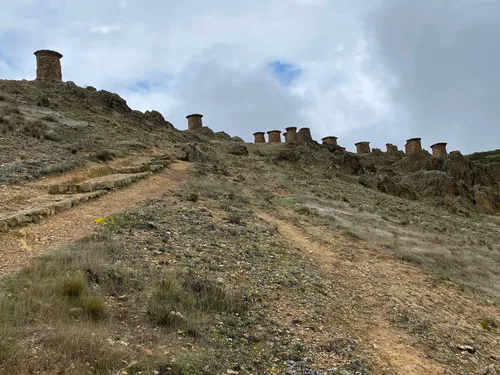Peru Feb 20-March 10, 2025
Day 6 Fri/Sat Feb 21-22
PERU – PERUVIAN AMAZON (Loreto, San Martin)
LETICIA, COLUMBIA TO IQUITOS, PERU BY BOAT
I flew on Latam from Bogota to Leticia.
There is very little information on these ferries and all I could find was quite dated.
Currency: Official rates: 1 US$ = 4,120 COP = 3.7 PEN
LETICIA
With flight-only access, I arrived at 8 pm. A taxi offered 50,000 COP for the 1.6 km ride so I walked 20 minutes to my hostel – Jangada Hostel & Tours Amazonas (50,000 COP/night in a dorm room, a good information source and many other travellers, no English).
Do. See the Ethnographic Museum (good exhibits on indigenous people in one small room, free). Walk about 1.5 km to Tabatinga, Amazonas Brazil (no visa, no office, walk across the border) but there is little to see.
Immigration. The only place to get an exit stamp for Colombia is at the airport (I took a moto taxi (10,000 COP) there and got the stamp in 2 minutes).
Money. There is no money exchange in Santa Rosa – ensure that you have PEN as that is the only way to pay for the ferry and purchase anything on board.
I took a tuk-tuk to the port in Leticia and exchanged money and bought a few supplies on the way.
There are many long-tail boats to take you from Leticia port to Santa Rosa, 10 minutes across the Amazon.
SANTA ROSA PERU
Immigration Peru. Take a tuk-tuk to the immigration office in town and then to the ferry on a muddy narrow track.
FERRIES Santa Rosa to Iquitos
It is not possible to reserve a space on the ferries and there is minimal online information.
Buy tickets on the ferry. The Amazon for the entire length is still a huge river, a few km across and with brown muddy water. Because it was the rainy season, the river was high and the boat travelled right next to the shore. It occasionally takes narrow channels around islands. We saw a small pod of pink dolphins.
In 2022, I took a ferry from Santarem to Manaus Brazil taking 3 days. The river is probably 5 km wide, infrequently went near the shore and had few stops but was a much more sophisticated boat compared to this ferry.
1. Fast ferry. Leaves Santa Rosa at 12 noon on Tuesday, Thursday and Saturday. 120PEN. A man who took it the same day as me on the slow ferry said it took 25 hours with no stops or anywhere to sleep. It was horrible.
I would take this only if I had time constraints as it zooms down the middle of the Amazon and you see nothing. The slow ferry is a much better experience. I also preferred to not arrive in Iquitos in the middle of the night.
2. Slow ferry. Leaves daily at 16:00 and takes “3 days”. It left at 16:15 and took 44 hours arriving at noon after two nights. 80 PEN including 3 meals/day. Arrive by 3 pm.
I purchased a hammock on the ferry (15 PEN)
The slow ferry is the “Amazon” of the Amazon servicing every small village on the way. We had about 20 stops all on about the first half on the south side of the river. It is a great experience seeing village life and the loading and unloading of cargo and people in every village. The cattle and pig loading was quite inhumane. Some stops were as short as 2 minutes and as long as an hour. At one larger village in the middle of the first night, several “inspectors” came on board, shined flashlights everywhere and as I was awake asked to see my Peru entry stamp.
The foreigners on the boat were 4 Chinese men, a couple from Tokyo, a young woman from San Francisco and amazingly, a traveller from Darfu, Sudan. He must be quite the traveller as he got off 3 hours before Iquitos and got a local speed boat to wherever he was going.
Sleeping. At the end of the ferry ride in Iquitos, there were about 25 hammocks and at least 12 people sleeping on the floor. The hammocks are strung about 2 metres at the ends and hang in a marked curve. I am a stomach sleeper and was unable to get any rest so I laid my sleeping pad (Nemo) and my sleeping bag (Western Mountaineering Mity-Lite, the best travel bag) and slept well with the constant massage from the engines of the boat.
Food. A bun and milk tea was the first dinner so I purchased an excellent meal of rice, fried plantains and fried chicken (15 PEN). The 2 breakfasts were a bun and milk tea, the one lunch and two dinners were rice, a small amount of pasta or slaw, beans and a small piece of chicken. Much better meals (rice, plantain, a big piece of fried chicken or fried eggs or fried sausage) could also be bought along with soft drinks, water, snacks and beer.
I brought my own instant coffee, sugar and hot water was free.
WIFI. Starlink on the boat, free and very fast.
Power. There are many charge points to charge your devices.
Toilet. The toilet was quite menial and had an equally menial shower. A sink had water and soap – all used silty Amazon water.
IQUITOS
This is a surprisingly large and busy city with many tourists. Most are here to do 3-day jungle tours or to go to the jungle and do ayahuasca. Some have done this hundreds of times.
I arrived at 12:30 took a tuk-tuk to my hostel and went for a walk to Mi Museo Iquitos.
On the way, I stopped and watched 4 men playing a different version of rummy (Go to my Traveller’s Card Games post to see the rules I could figure out. On the way back, I then watched them play for an hour and had a good understanding. Not one person acknowledged my presence or even looked at me.
The museum was closed on the weekend. I returned to my hostel where there were two great young Japanese tourists that I smoked with and went out to a Chinese restaurant. They spoke good English (which is unusual) but still had difficulty with good conversation.
ON Moicca Youth Hostel for two nights (66 PEN /2 nights, breakfast included. No aircon but reasonable fans and still very hot through the night. Good breakfast.
Day 7 Sun Feb 23.
I had a lazy morning, then left this hostel for one closer to the centre with A/C.
Mercado Belén. An enormous street market occupying several blocks of one street with stalls extending down every side street. First, there was produce (a lot that must go bad), some meat (chicken, spiced slabs of beef). clothes, and then several food places. I ended up in Belen and walked back on the next main street over, mainly used by tuk-tuks.
There were several manicurists and I had my toe nails done (dark red) or 30PEN. It was great fun talking to the women including one getting her nails and eyeblows done.
ON Flying Dog Hostel. Cheap and good A/C. Just an OK breakfast.
Day 8 Mon Feb 24
I went on a walkabout to see the rest of the sites in Iquitos.
Museum of Indigenous Amazonian Cultures. Don’t miss this great museum with good English explanations. Many good exhibits on multiple communities – there are 100 noncontacted tribes – pottery, ceremonial feather headdresses, blowguns, pre-Colombian pottery, and a drum that could be heard 20 km away. Impacts of the original Spanish, missionaries and the rubber boom of 1880-1912. 10PEN
Ex Hotel Palace (Architectural Delights). Dated 1908-12, this is a two-story building with a facade of tiles and silver wrought iron balconies. It is now a “military office” and I was allowed in for a minimal look at the courtyard.
Ayapua (Maritime/Ship Museums). At the Historical Boat Museum, it is a three-story steam launch built in 1906 with many exhibits – early Amazon maps, the early exploration, tourists, a chapel and the founding of the town in 1864 when the Peru Navy arrived. 10PEN.
BAP America (Maritime/Ship Museums). This is listed as a boat in Iquitos but no longer exits.
Mi Museo Iquitos. After missing it on Saturday, I walked 1.5 km back to it. Many large wood carvings, the customs, pre-Columbian and modern art of the Amazonian Indigenous peoples, the history of the department of Loreto, highlighting from the rubber boom to the Colombian-Peruvian war.10PEN
I hung around the hostel till 6:30 pm, went to Dawn of the Amazon with Adam for dinner (excellent fajitas and took a tuk-tuk to the airport.
Flight. Sky Airline Iquitos to Cusco @21:30-06:30+1 with a 4 1/2 hour stopover in Lima
I met Luciano from BA on the flight and he paid for the taxi into town.
Go to Peru – Southern Sierra (below).
RIO ABISEO NP WHS is home to a large number of species of flora and fauna, as well as over 30 pre-Columbian archaeological sites.
The park comprises an isolated river basin covered by forests, transitioning into a mountain landscape at higher elevations. The critically endangered Yellow-tailed Woolly Monkey is known to live in the park and relies on it for its survival as a species. The most famous archaeological site in the park is Gran Pajatén, a ruined settlement that was occupied between 900 and 200 BCE, and 200 BCE to 600 CE.
This is one of the most difficult to visit WHS in South America. 3 days of travelling to see only a tiny corner of a vast national park
21-hour overnight bus from Trujillo (Chan Chan) to Tarapoto and then 3 hours by minivan/colectivo to Juanjui. From Juanjui, 40 minutes by car to Huicungo, a village on the Rio Huayabamba. 30-minute boat ride upstream to Río Abiseo which runs into Río Huayabamba, then 1.5 hours upstream to the lodge. Parts are very shallow and may need to wade. Boat into the National Park/WHS for about 30 minutes to the Catarata Maquisapa. This is the only place visited in the WHS.
Summary: Fly Lima to Tarapoto (2 hours), drive to Juanjui (3 hours). The next day, drive by car and boat to the waterfall Maquisapa (4 hours one way) and back to Juanjui the same day. Recommend stay 2 nights in Abiseo Lodge (Website) next to the park ranger house and only a 10-minute boat ride from the official NP territory. the lodge. Catarata Maquisapa 15 meters; a 15 minute walk. The lodge is in “high jungle”, not flat and low like Amazon rainforest. There’s less wildlife compared to Manu. An adventure & nature holiday.
Tentative WHS
Chachapoyas sites of the Utcubamba Valley
Sierra del Divisor National Park
++++++++++++++++++++++++++++++++++++++++++++++++++++++++++
PERU – SOUTHERN SIERRA
Day 9 Tue Feb 25
CUSCO
I arrived at the hostel at 07:30 and hung around till 11 when I went to Bonanza Tours to get the details of the trip to Manu NP. I bought the things not available – cigarettes, milk, instant coffee and exchanged US$100 for a bad rate of 344Soles.
I was able to get to my room early and had a short snooze.
ON Viajera Cusco Hostel. With 200 rooms, this may be the largest hostel in the world. Lots of rules and an active restaurant/party scene. I am twice the age of anyone here.
Day 10 Wed Feb 26
I was up at 03:30 ready for the pickup by Bonanza at 04:15. It was a 12 hour drive to Manu via the cloud forest.
PERU – MADRE de DIOS (Puerto Maldonado) and UCAYALI
MANU NATIONAL PARK WHS has a biodiversity that rarely can be found in any other place on Earth.
The isolated park comprises the catchment basin of the Manu River and part of that of the Alto Madre de Dios River. It holds an extremely broad range of ecosystems, resulting in high diversity and a high degree of endemism. Virtually all flora and fauna species are present in abundant numbers: more than 15,000 species of plants are found in Manú, up to 250 varieties of trees have been found in a single hectare and the park is home to over 800 species of birds. Furthermore, it’s a refuge for globally threatened mammal species such as Giant Otter, Giant Anteater, Ocelot and Jaguar. Enormous variety of trees, plants and monkeys.
The real indigenous are the Mashco Piro who still run naked through the jungle and live as nomads with low contact with people. It’s dangerous to meet them as we can not communicate with them. They have already killed two civilized locals on encounters with bow and arrow. Even more dangerous for the forest though are the Matchiguenkas as they as well as the Mashco Piros are allowed to hunt and cut trees in the national park. However, they originally came from the mountains/ Cusco region. Now they use their privilege to kill special animals and cut special trees to sell. The park rangers belong to the same ethnia so they will not stop them.
Bonanza Tours Peru Feb 26 – Mar 05 Manu Reserve Zone and Blanquillo Macaw Clay Lick to Pto Maldonado 8D/7N
Deposit US$105 paid 24/12/25. I paid the rest by a Wise transfer of 1590US$.
E Mail: info@bonanzatoursperu.com // +51 84786804
Calle Suecia 343 – Cusco – Perú. Mon. – Fri. 9 am until 5 pm
Start: Cusco End: Cusco. 4-8 people
Altitude Cusco (3,300m) Andes (3830m) Elfin Forest (3159m) Cloud Forest (1,500m) Amazon Basin (290m)
The best season to come here is October/November to see the best wildlife and the trees are actively flowering. July/August is the busiest with Americans coming in their holidays.
Be aware that many tour agencies in Cusco offer trips to Manu, but these are cultural tours seeing only the cultural areas and not the core part of the park.
Our Group. An older couple from India (from Bangalore and living halftime in Dubai), a 31-year-old Italian man from the north German part working in Berlin, and a 31-year-old German woman from Hamburg.
For the first day in the van, there was a driver, cook and the guide. The driver left in Atalaya when we boarded the boat.
Alex, our guide, was excellent. He knew the name of every bird, insect, spider and mammal we saw. He was constantly scanning the shores of the rivers and seemed to be able to spot anything. He heard the smallest sound (a poison frog). And he was so enthusiastic.
The food was excellent and the rest of the staff very attentive.
Day 1 Wed Feb 26 Cusco – Rainforest Lodge (community-owned), Patria
There are three archaeological sites on the drive to Paucartambo. We didn’t see the first two.
Parque Arqueologico Tipon. The Tipón complex is located near Oropesa, 27 km southeast of Cusco and next to the Cusco- Puno highway. At 3,560 meters above sea level, Tipón was a sanctuary where water was worshipped. It contains enclosures, terraces and a large irrigation work on the terraces, also called platforms, and an intact irrigation ditch with an incredible distribution of open-air water conduits.
The upper part of the complex is crossed by the Inca Trail. It was probably used as a laboratory for agricultural products due to the various microclimates found in this complex.

In the times of the Incas, there were no flat or horizontal lands; everything was modified by the determined inhabitants of Tahuantinsuyu to the satisfaction of their veteran monarch.
Pikillaqta Archaeological Site is a large Wari culture archaeological site 20 kilometres (12 mi) east of Cusco. The site was occupied from about 550 to 1100 AD. Its main use was for ceremonies and the site was not complete when it was abandoned.
Located 3,200 meters above sea level, the climate is cold and arid. Maize was an important crop, farmed using substantial irrigation systems. Canals, reservoirs, aqueducts, terraces and cultivated fields. Water for irrigation was mainly by rainfall, which led to the hydraulic system. In August through December, there was hardly any rain and the artificial irrigation system was used. May through June was the harvest season. Canals were built of stone and were connected to the Lucre River and Chelke stream. There are over 48 thousand meters of canals. Canal A provided water for irrigation at terraces 1, 2, 3, and 4 and was connected to aqueducts. Canal A provided for the most important buildings in the center of Pikillaqta.
Around 1100 AD, it was ultimately abandoned.
We left Cusco in a Mercedes Sprinter at 04:30 and drove through the mountains to Paucartambo for breakfast and a short walk. The town has a folkloric dance festival in mid-July. The small square has several life-sized statues of people dressed up for the festival.
The road had been completely renovated one year previously but had already developed potholes.
Tres Cruces, the entrance to the Cultural Zone of Manu and the cloud forest at Acjanaca Pass (3500m).
Starting at Paqiraq (Pacchayoq) waterfall (2484m), we walked down the road several times to see butterflies and birds. We didn’t see any monkeys (Wooly) but saw one Cock of the Rock, the national bird of Peru (Rupicola peruviana), and a few other types of birds. The trees had many epiphytes and orchids. We spent hours looking in vain or seeing one bird.
ON Rainforest Lodge near Patria. There was a lovely large dining room and separate bungalows with mosquito nets (although there were no mosquitoes) for a wonderful sleep after not sleeping for the previous 2 nights (overnight flight Iquitos to Cusco, and I took a decongestant for a cold and didn’t sleep in Cusco).
Day 2 Thur Feb 27: Drive to Atalaya, boat to Aqua Caliente (hot springs), boat to Bonanza Lodge, one-hour walk to Camouflage Lodge.
We followed the Madre de Dios River to Atalaya.
We stopped at every bird and monkey sighting, spending a long time looking up into the canopy, which often ended up being rewarding to finally get a good view.
Capuchin monkey. One was very cooperative
Hummingbird Lodge. A king vulture on the other side of the road. A habituated toucan came right to us, wanting to bite my painted toenails. It had spectacular colouring.
A large open building with many hummingbird feeders. They are mainly here in the dry season, and we only saw one. A walk through the jungle: bird of paradise flower, cilantro, natural cacao, cinnamon, coca, a spectacular emerald boa languishing on a branch, natural bees with a tiny trumpet hive.
After a short drive to Atalaya, we left the van and boarded a 17-meter-long
boat – 6 bucket seats, canopy roof, tons of storage, outboard motor for the trip down the Alto Madre des Dios River, a wide, brown, fast-flowing river. On the left (north) was the cultural area of Manu NP (many tourist lodges, few animals, cheap 3-day tours) and on the right, farming. We passed a large banana plantation with many bunches on the shore to be taken to Cusco.
Roseate spoonbill – a family of 6 on a sandbar in the middle of the river. The boat turned around to see them.
Boat to Aguas Calientes natural hot springs. Contained by a large rock dam and rock walls forming a bench. The 60-degree water from the hot springs flows into the side of the pool (some was diverted past the pool), and a natural stream of cold water flows into the back, so the water got hotter the closer it got to the dam (and was intolerably hot). Everyone else smeared mud on their faces.
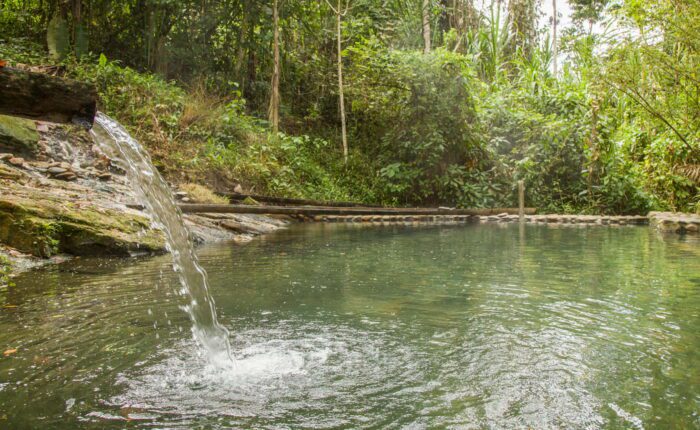
We then boated down about one hour to Bonanza Lodge.
Bonanza Lodge was a 5-minute walk from the river and was similar to Rainbow Lodge with several individual cabins and large buildings.

We left at 15:30 to walk for one hour to the Camouflage platform deeper in the jungle. We carried basic things – toothbrush, sleeping bag, mosquito repellent, Kindle, cards, binoculars, and all our water. The good trail crossed 4 small creeks.
ON Camouflage Platform. A basic post and beam building elevated 10 metres off the ground. It overlooked a 20 m round pond with greenish water, the clay lick. There are no facilities or bathrooms, and we brought a small box dinner. The platform had steep stairs and was long and narrow, probably able to accommodate 12 people on mattresses. We took 1-hour shifts throughout the night, checking every 5-10 minutes with a small, strong flashlight, and then warned the others when animals appeared.
Tapirs were present throughout the night, usually one, but there were three at one point: two males and one female. We also saw three deer, a bird, and a guinea pig. Being woken up frequently was very disruptive, and I barely slept. Mammals clay lick.
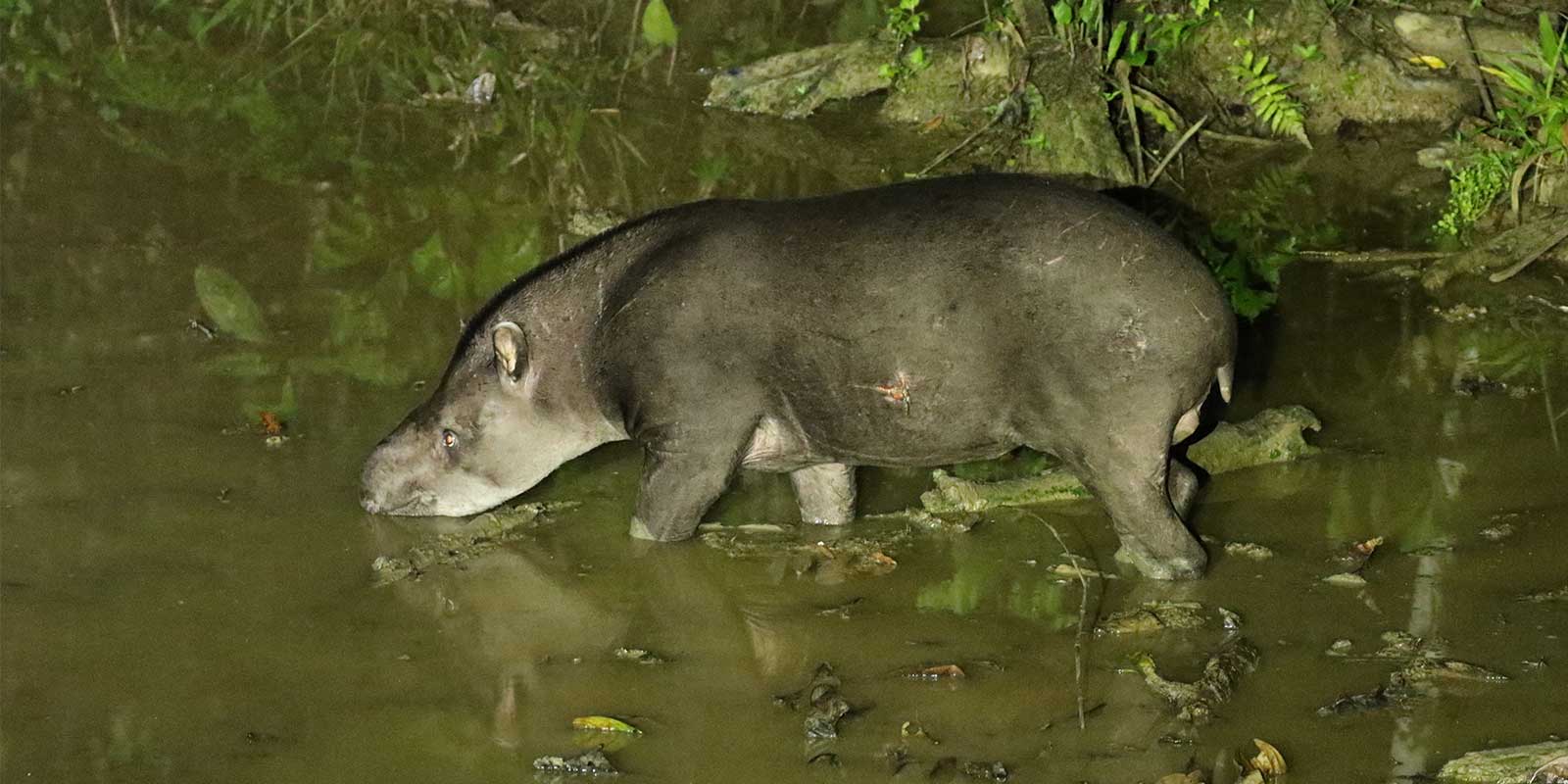
ON Jaguar Ecolodge. Only 3 years old, it is beautifully constructed of wood milled on the site. Like the other lodges, there are several individual cabins and a large central dining room. Skylink provided fast Internet.

Day 4 Sat Mar 1
The mosquitoes and sandflies were very aggressive. I was a little lax and ended up with a hundred sandfly bites (don’t itch).
Cocha Salvador. We left at 05:40 and had a simple breakfast on the boat. It is best to go very early to try to see the otters. Boat about 10 minutes downstream and walk about 10 minutes to the lake, another oxbow lake, but full of water and much longer. The catamaran had two big green metal pontoons with a seat at the back of each for the paddlers. A large square deck had 4 benches. We went down one side for about 15 minutes and encountered the family of 8 otters (all of the known otters on the lake) out to feed. They swam fast, breaching like small whales. Several had caught fish – they tended to go against small logs sticking out of the river to eat. We followed them along the shore for almost a km.


Across the lake, we saw an endless variety of birds, 4 howler monkeys, a mother capacino monkey with a baby on her back and one black caiman swimming across the lake in the distance. It was an incredible experience, one of my best wildlife experiences ever.
Back at 10:30, we all had a nap and then a delicious lunch of salad, ceviche, avocado salad, fried rice, and potatoes.
Pakitza. About an hour upstream, it is the farthest tourists can go in the park. We registered at the ranger station and were the first visitors in 2025. There were only 77 in 2024, and all but about 10 were Peruvian.
The clay lick had been flooded for some time, so we took another trail out and back. After about 10 minutes, we were stopped by a washed-out bridge. We returned and went along another trail, which was soon blocked by fall and overgrown bush.
Back at the ranger station, I asked the head ranger why nothing had been cleared or the bridge fixed. Three male rangers had done zero work in the last 2 months to services from Pakitza.
ON Jaguar Lodge. I made an avocado salad (with instructions from Bernadino for seasoning) for dinner.
Day 5 Sun Mar 2
The river had risen several feet overnight, and we could only access the boat down the “shortcut” trail. The river carried a pile of debris – old logs and branches. It must have rained very heavily in the mountains above Manu.
Matsiguenka, just 10 minutes downstream from the Jaguar Lodge, is the indigenous owned lodge Casa Matsiguenka, which is rarely used since Jaguar Lodge opened. The buildings had palm thatched roofs and rustic buildings in need of maintenance. The one trail used to go to a mammal clay lick, but that has been overgrown for years. We saw a poison frog (black with lime green stripes on its back and legs). We walked about 30 minutes, crossing two bridges to arrive at the well-designed blind across the small creek and the steep iron-stained river bank where the birds come. We had been instructed to wear dark clothing and be absolutely quiet to avoid scaring off the incredibly skittish birds. We had brought books to occupy ourselves for the often long waits.
Eight chestnut-fronted macaws arrived, all actively eating the clay. P, in his light grey top, stood up, and they flew away to not return. After a 30-minute wait, one blue-throated pin pin Guan (a turkey) arrived and spent 10 minutes on the lick. No other bird appeared for the next 2 hours, and we got to read our books.
We returned to the lodge for lunch.
Lake Salvador. We returned to see caimans but didn’t. There were several monkeys – many spider monkeys, capacino monkeys and the giant otters again.
Night walk. Saw many spiders.
ON Jaguar Lodge for the second night.
Day 6 Mon Mar 3. Jaguar Ecolodge – Blanquillo Lodge.
Boat 6 hours trip down river to Tambo Blanquillo. The logs and branches on the Manu River had all washed downstream.
Limonel Ranger Station. We signed out and filled out a long survey about the animals we had seen and evaluations of park facilities. We walked along a trail for 10 minutes to a high observation tower on the side of a lake, passing some huge trees. There are 21 species of Ceibos tree, of which the kapok tree is one. One was a massive Ceibos kapok tree. They grow to 60 m high with a diameter of 3 metres. Each tree produces 4000 fruits, each with 200 seeds. The wood is used to construct rafts.
The tower was on the side of a swampy area surrounded by Moorish palms that grow to 35 m and are the trees used by macaws to roost and nest. The Cumaric tree grows to 40 m with a one-metre diameter trunk (4 m diameter at the buttress roots.
We stopped at Boca Manu, a tiny village that had been washed away in a recent flood. It was much larger then with a stadium. The chef bought some supplies, and we all got a Coke.
We entered the Madre de Dios River, now twice the size it had been. We passed the lodge area about 10 minutes downstream to walk to the Blanquillo Macaw Clay Lick. The half-hour trail was covered in water. We started to complain when the water went over our gumboot tops. With the “youngsters” in front, we forged ahead with the water getting slowly deeper, climbing over logs and vines. It reached our crotches, and we took our daypacks off and carried them on our heads. When the water was nipple height with no sign of getting shallower, we finally turned around. Our guide, Alex, is only 1.5m tall (5’1”) and would have needed a snorkel to get as far as we had been.
In the past, the lick could also be reached on a 1 ½ hour trail directly from the lodge, but it too was under water.
ON Blanquillo Lodge. This is a privately owned lodge (Spanish owners) up a side river channel. The last tourists were here on December 20, 2024, and the trail had been underwater since early January. The lodge was then also surrounded by water, and all their chickens and ducks had died, with nowhere to reach high ground.
The lodge was much more rustic than the luxurious accommodation in the Bonanza lodges that we had become used to. The rooms were under a huge roof but divided only by thin partitions, so Lucas’ snoring kept me awake. The only lights were in the bathroom area. There was another lovely building screened in for the copious mosquitos, lights, great Skylink wifi and a nice table tennis area. Lucas and I played several games (he was much better than me).
Day 7 Tue Mar 4. Blanquillo Lodge – Puerto Maldonado
Macaw Clay Lick. The boat driver knew a way by water to the lick. Further downstream, we entered a side river. There were several downed trees, logs and debris in the water, each time thinking that this was the end, but he managed to get by it all. We finally reached the huge blind, now surrounded by over 2 metres of water. The boat managed to access the stairs at the back.
The blind looked across the river (now lake) at a much shallower cliff about 150 m long. The blind was two large buildings, one with 23 seats and the other with 30 seats connected by a long walkway. Great large photographs of animals and information lined the walls of the walkway. There were bathrooms on the blind.
Many mammals also use this lick for the clay, but for the jaguars and ocelots, it is also used to get birds on the lick. Capybaras are also common.
The chef provided a breakfast of fresh fruit and puffed rice, toast and coffee. It had been raining heavily, and it turned into a major downpour. The birds are less likely to use the lick when it is raining. We had a lovely wait in the tranquil setting (I wrote this part of the post and caught up on the book I’d been reading).
In the pouring rain, in the trees, we saw two kingfishers, a parakeet, a Meyli parrot, and a tiny hawk that preys on lizards. Finally, a yellow-crowned parrot was eating clay hanging from a branch while its mate stayed on another branch.
It rained heavily all morning, and at noon, we returned to the lodge for lunch.
The rain stopped, and we returned at 14:30 to spend the afternoon at the lick. At 14:35, about 20 parakeets arrived on the lick, then a capybara,
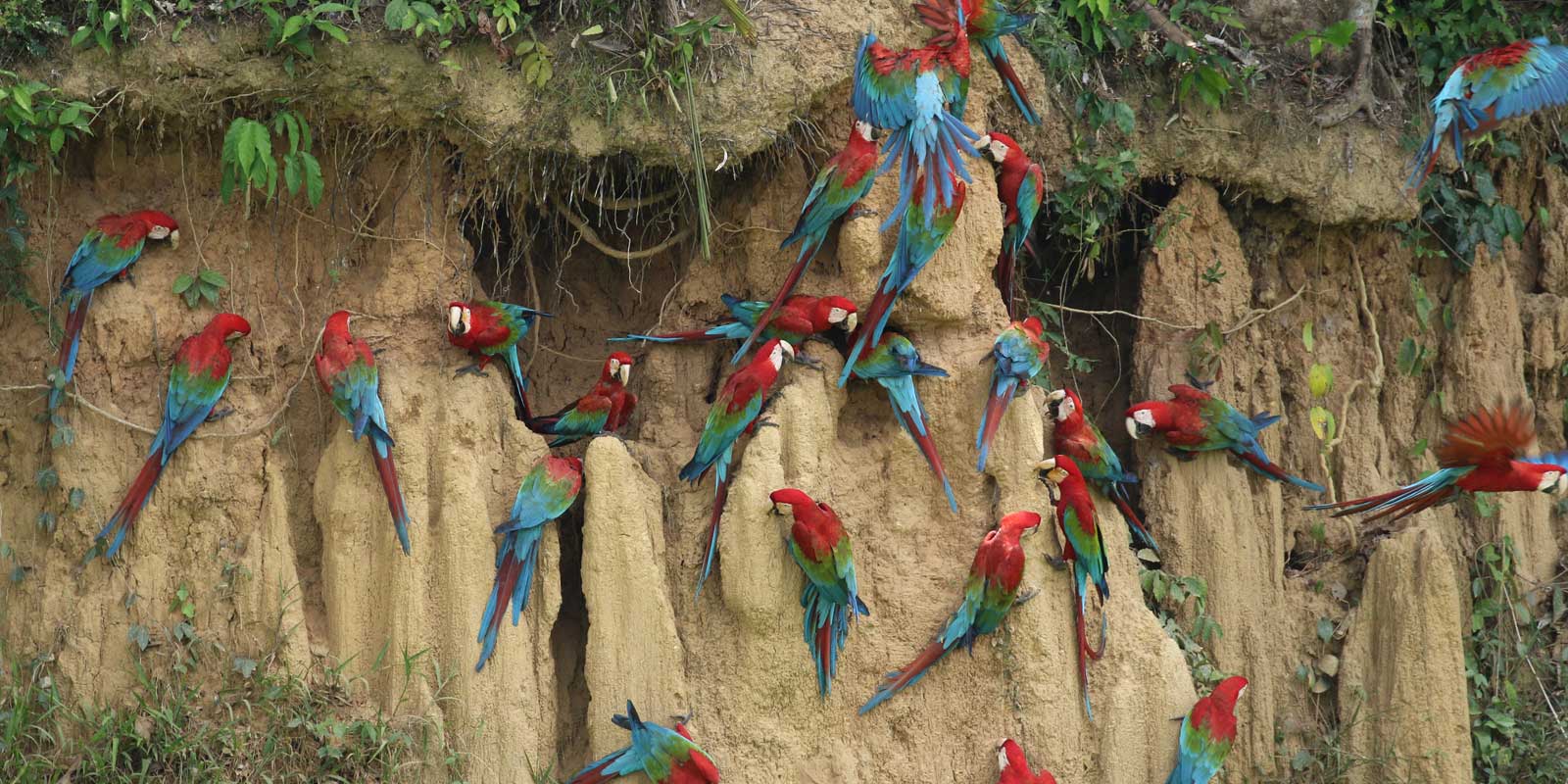
ON Blanquillo Lodge for the second night.
Day 8 Wed Mar 5
Leave at 6 am on the boat downriver to Boca Colorado, car 40 minutes to Puerte Carlos, cross a big river 10 minutes, a car passing through Mazuco to Cusco. 14 hours total.
ON Viajero Cusco Hostel for the 3rd night.
Day 9 Thur Mar 6
CUSCO
Museo De Historia Natural. A great display of stuffed animals, fossils, potatoes, corn, armadillos, and much more. 10PEN, free on the day I went.
Inkaterra La Casona Hotel. This is a very old hotel. I walked around it but could not find the entrance. Casona’ means large house or manor home in Spanish, and the Inkaterra La Casona hotel Cusco, the only Relais & Châteaux Property in Peru, certainly feels like home. In keeping with the vision of the original occupants of this manor house, guests knock on an old unmarked wooden door before being led into the opulent and immaculately restored colonial building by the doorman that greets you and reassures you that yes, you are in the right place.
Eleven sumptuous rooms set around a typical colonial-style courtyard make up one of the finest luxury boutique hotels right in the heart of Cusco. Every element of the building and service has been created with astonishing attention to detail.
Each stone in the building has been catalogued by the Peruvian National Institute of Culture and the lovingly sourced antiques and objects decorating the hotel dating from the Incan, colonial and republican eras make this one of the finest examples of colonial history in Cusco.
The rooms are sumptuous and exquisitely decorated in a hacienda style. Underfloor heating, soundproofed windows, and a lounge area make this one of our top picks for luxury boutique hotels in Cusco. Hospitality Legends:
Museo Maximo Laura. A beautiful museum with wonderful mosaics in brilliant colours. 10PEN
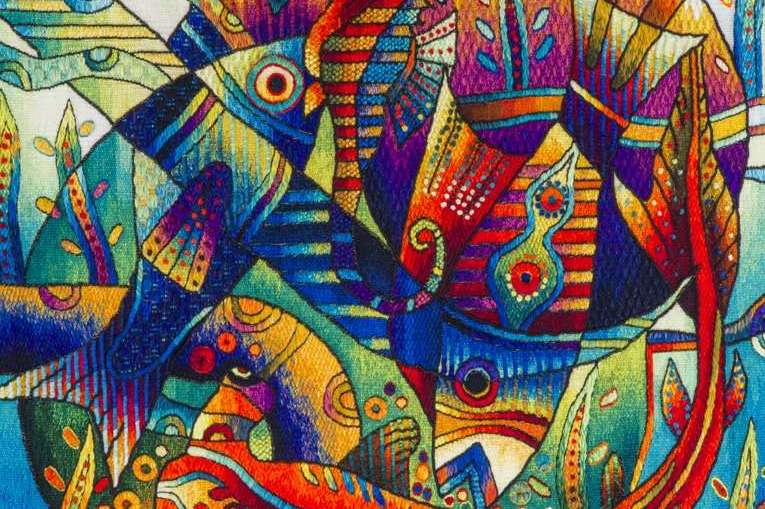

![]()
Qoricancha Site Museum. This was the main Inca temple, once with walls of gold. Much is covered by the Iglesia Santa Domingo, which used many of its building stones for the church. Several Inca structures surround the cloister of the monastery associated with the church. It was the richest temple in the New World. It was interesting to see how the stone blocks interlocked with grooves and postholes. 16 important wakas (temples) of 328 total were connected by seges or imaginary lines to this temple. 20PEN, no reduction
I bought a SIM card (Claro 35PEN), a cup, coffee and sugar for my future travels.
Bus Palamino Bus Lines. Cusco to Ayacucho 21:30-13:30+1. 80PEN
I booked this on RedBus, the only site I could find. The departure they listed was 20:13, taking 12 hours.
ON on bus. I had a 160-degree reclining seat to myself, my sleeping bag and a pillow, but I still slept erratically. The driver stopped once for breakfast (these drivers are obsessive).
+++++++++++++++++++++++++++++++++++++++++++++++++++++++++++++++++++
PERU – CENTRAL SIERRA (Ayacucho, Junin)
Day 10 Fri Mar 7
AYACUCHO
On a Friday afternoon, there were many out walking and eating. There is a huge market, parks, and a long pedestrian street. I didn’t see any other gringos all day.
I arrived at my hostel at 2 pm and went for a walkabout to see the sites in Ayacucho.
Andres Avelino Caceres Museum. Andrés Avelino Cáceres (Ayacucho, 1836-1923) was a Peruvian military man and politician, hero of the resistance during the War of the Pacific and Constitutional President of Peru in two periods: 1886-1890 and 1894-1895. He is the patron saint of the Infantry Weapon of the Peruvian Army.
Enter a large courtyard with guides from the Peruvian military. See many portraits and photos including his family, weapons, many leather trunks, a chapel, printing press, and upstairs, the living quarters with many personal effects. 5PEN.
Basilica Cathedral. A triple nave church with OTT gilt baroque side chapels and altar.
Casa Museo Joaquín López Antay. (1897 –1981). This man is an artist who constructs elaborate retablos using many complicated figures and bright paint. House and Biographical Museums
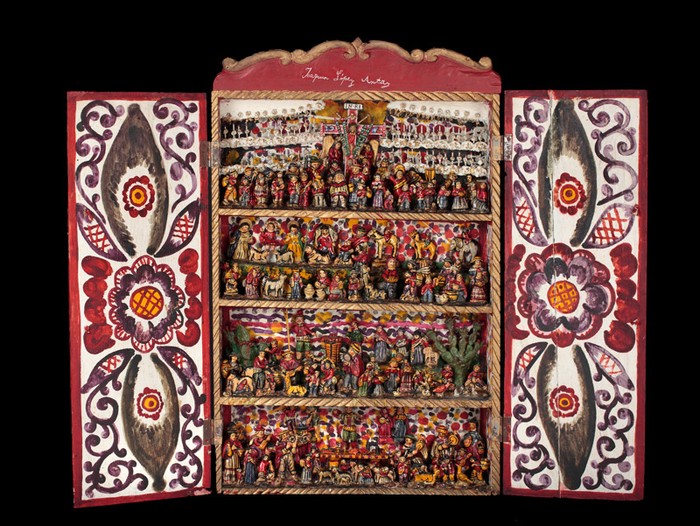
Templo de Santo Domingo de Guzmán. A very early single nave church with a rough brown stone exterior. Baroque chapels and altar and lovely ways of the cross (small ceramic bas-reliefs.
Museo de la Memoria. Details the period from 1980-2000. Afer the 1980 election, the communist part (the Shining Path) conducted several attacks on police stations and electrical grids. The military and police conducted a reign of terror, killing and disappearing many citizens, mostly from the period 1980-85. The Dark Side
Museo Historico Regional Hipolito Unanue is an archaeology and anthropology museum with five exhibition halls about the Early period and many Peruvian civilzations, Ayacucho Popular Art, and Republican History. 10PEN
It started to rain heavily on my walk back to the hostel. I stopped and had a fairly good pizza.
ON Casa Sucre Hostel. Close to downtown, this a a great place with a good kitchen and sitting areas. 20PEN (US$6), a great deal.
Day 11 Sat Mar 7
I was up working in the middle of the night, then went back to sleep. I packed and stayed at the hostel till the evening (she was an incredible host), when I took a taxi to the bus station.
ON Bus Molitours Ayacucho to Huancayo. 21:00-12:00. 35PEN. The road was terrible, narrow, full of potholes, and mostly gravel. We rarely exceeded 30 km/h and often could only go 10 km/h. At about 06:15, the road was washed out. Several cars got through by gunning their engines and driving fast. A bus got through from our side. One car from our side went too slow and got stuck in the middle. Several guys waded into the water and tried to push him out. The bus eventually crossed with few problems.
We finally were on good pavement at Huancavelica, about 100 km and 2 ½ hours from Huancayo.
I didn’t sleep a wink on the rough part and then it was only 3 hours to Huancayo.
Day 12 Sun Mar 9
Huancavelica. We passed through this small city. St. Anthony Cathedral was constructed by the Tonsurados and finished in July 1608. The predominant architectural style is Churrigueresque Baroque.
It is located in front of the Plaza de Armas, in the center of the town. The retablos, canvases, pulpits, and other decorations and finishes continued to be worked on and perfected during the following decades.
HUANCAYO
We arrived at 13:00, making for a gruelling 16-hour bus ride to go 297 km.
The Molitour office is downtown.
Bus to Cusco. On RedBus, none of the many bus companies had any sleeper seats available. I got a taxi to the main bus station. The central hall is huge with 20 bus companies but only two were open. None accepted credit cards. One wanted 160PEN for a sleeper seat (it was in the double side) so I went to Carmelitas Express who had several seats and I got the choice one (the front of the single row) for 70PEN.
I sat outside the airport for a long time, repacking my stuff. From the airport, I took a taxi to an ATM and then out to the rock formations.
Torre Torre (Rock formations). They are actually large hoodoos with the column of soft material and a large impermeable cap rock. There are trails throughout the formations, including ones to the top of some of them.
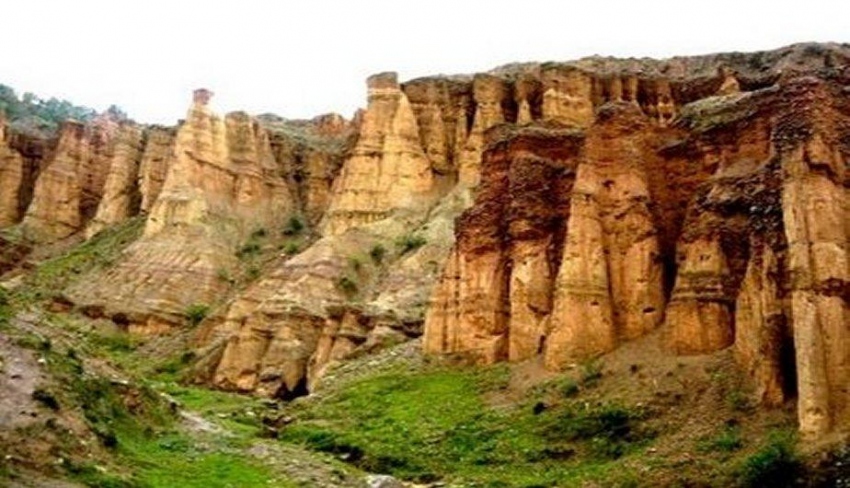
Museo Salesiano Vicente Rasetto. Closed on a Sunday.
Lugar de la Memoria de la Región Junín. Closed on a Sunday.
Huancayo was a sleepy place on a Sunday. The place to go is the mall which was very busy. I ate at a KFC and sat till 20:30 in the food court and at a Starbucks, charging my computer and doing work. I was exhausted and fought off sleep so that I would sleep on the bus. In contrast to daytime, the terminal had thousands of people as all buses seem to leave between 8 and 10 pm.
ON Camelitas Express Bus Huancayo to Lima @ 21:30-06:00 +1. Sleeper seat. 70PEN.
Supposedly a 10-hour trip, it turned into 18. At about 3:30 am, on the 4848 m high pass at Ticlio, we were stopped by about 4″ of snow. No one moved until it all melted. It was -4°C. We were first in a line that stretched back for hundreds of cars and buses. A backhoe arrived that I assumed plowed the snow. We finally started moving at 9 am and arrived in Lima at 14: 30.
GO TO LIMA.

